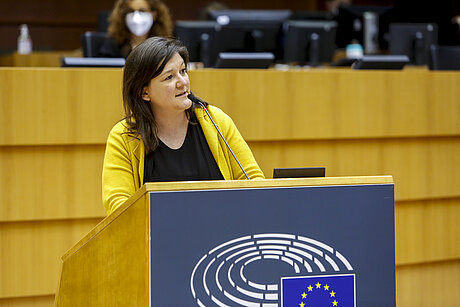In 2009, the EU had already developed a directive on the permissible standards for asbestos in the workplace. There was a growing awareness that these standards were far too high to protect workers against this carcinogenic substance. Cindy Franssen, MEP, was very well informed about this and made the realization of a solid new guideline her central point of action in the European Parliament (EP).
It was very important to make that adjustment now. To meet the rising energy expenditure and to achieve the climate objectives, Europe is strongly committed to the renovation of buildings. However, asbestos is still present in a large part of these buildings.
Laetitia Baldan/Jan Franco of ACVCSC-BIE: “Asbestos-related cancer is the leading cause of death in the workplace in the EU. The number of workers exposed to asbestos is expected to increase by 4% over the next decade, due to building renovations under the European Green Deal.”
During the negotiations between the EP, the European Council and the European Commission it was clear that there was a huge obstruction, and the negotiations were very sharp. The core of the debate was, of course, achieving the lowest possible level of exposure and enforceability by adjusting the measuring instruments used.
On June 27th the negotiators reached an agreement. This will be voted now in the European Parliament and then the member-states have two years to include it in their own regulations.
Cindy Franssen: “If this invisible killer is not safely removed, an enormous amount of asbestos dust could be released into the air in the coming years. As a result, the number of asbestos cases and diseases may increase even further. I am pleased that the agreement reached on the stricter standards aims to prevent this and reduce it to a minimum.”
The agreement reached is clear: within 6 years at the latest, the asbestos exposure value for workers throughout Europe will be 50 times lower than the current limit.
This protection is achieved in two steps.
In a first phase, the limit value will be tightened from 100,000 fibers (per cubic meter of air) to 10,000 fibres. In a second phase, the value will be further reduced to 2,000 fibres. Member States have six years to meet the standard of 2,000 fibres. During that period, the new measurement method, which can measure values lower than 10,000 fibers, must also be rolled out.
In addition to the exposure value, the agreement also provides for additional protective measures, such as decontamination procedures for employees, to avoid secondary exposure to asbestos. Decontamination focuses on cleaning the body after exposure to asbestos and prevents asbestos fibers from being released outside the workplace.
The agreement also provides extra training for employees who work in asbestos removal.
Cindy Franssen: “In addition, and this is really important for the safety of the fire brigade and emergency services, the decision to bring together all information regarding the presence of asbestos in buildings and make it available for consultation cannot be underestimated. European money is also being made available for the member states to ensure a successful transition to the lower limit value.”
Laetitia Baldan/Jan Franco of ACVCSC-BIE: “The agreement reached represents a major step forward in protecting construction workers from asbestos. However, the long implementation period towards 2000 fibers per m³ means that workers will only benefit from the safer limit after most of the work has been completed as part of the renovation wave. ACV-CSC BIE, which has always followed this dossier very closely, will continue its fight and urge Belgium and the EU to move to lower exposure more quickly than today's agreement provides, as well as to proceed with innovative and differentiated measurement methods and procedures in order to have results on the spot and to allow safety-inspections for quick response and follow-up.”


